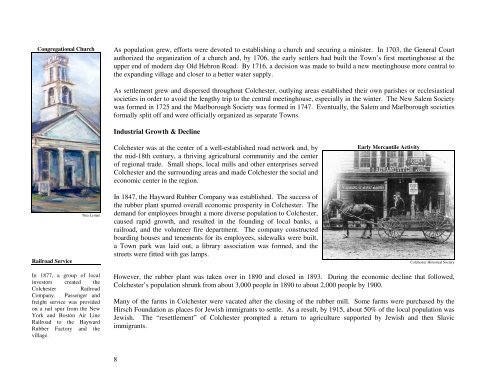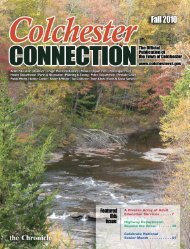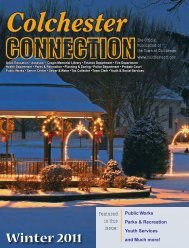2 - Town of Colchester
2 - Town of Colchester
2 - Town of Colchester
- No tags were found...
Create successful ePaper yourself
Turn your PDF publications into a flip-book with our unique Google optimized e-Paper software.
Congregational Church<br />
As population grew, efforts were devoted to establishing a church and securing a minister. In 1703, the General Court<br />
authorized the organization <strong>of</strong> a church and, by 1706, the early settlers had built the <strong>Town</strong>’s first meetinghouse at the<br />
upper end <strong>of</strong> modern day Old Hebron Road. By 1716, a decision was made to build a new meetinghouse more central to<br />
the expanding village and closer to a better water supply.<br />
As settlement grew and dispersed throughout <strong>Colchester</strong>, outlying areas established their own parishes or ecclesiastical<br />
societies in order to avoid the lengthy trip to the central meetinghouse, especially in the winter. The New Salem Society<br />
was formed in 1725 and the Marlborough Society was formed in 1747. Eventually, the Salem and Marlborough societies<br />
formally split <strong>of</strong>f and were <strong>of</strong>ficially organized as separate <strong>Town</strong>s.<br />
Industrial Growth & Decline<br />
<strong>Colchester</strong> was at the center <strong>of</strong> a well-established road network and, by<br />
the mid-18th century, a thriving agricultural community and the center<br />
<strong>of</strong> regional trade. Small shops, local mills and other enterprises served<br />
<strong>Colchester</strong> and the surrounding areas and made <strong>Colchester</strong> the social and<br />
economic center in the region.<br />
Early Mercantile Activity<br />
Railroad Service<br />
Tina Lyman<br />
In 1847, the Hayward Rubber Company was established. The success <strong>of</strong><br />
the rubber plant spurred overall economic prosperity in <strong>Colchester</strong>. The<br />
demand for employees brought a more diverse population to <strong>Colchester</strong>,<br />
caused rapid growth, and resulted in the founding <strong>of</strong> local banks, a<br />
railroad, and the volunteer fire department. The company constructed<br />
boarding houses and tenements for its employees, sidewalks were built,<br />
a <strong>Town</strong> park was laid out, a library association was formed, and the<br />
streets were fitted with gas lamps.<br />
<strong>Colchester</strong> Historical Society<br />
In 1877, a group <strong>of</strong> local<br />
investors created the<br />
<strong>Colchester</strong> Railroad<br />
Company. Passenger and<br />
freight service was provided<br />
on a rail spur from the New<br />
York and Boston Air Line<br />
Railroad to the Hayward<br />
Rubber Factory and the<br />
village.<br />
However, the rubber plant was taken over in 1890 and closed in 1893. During the economic decline that followed,<br />
<strong>Colchester</strong>’s population shrunk from about 3,000 people in 1890 to about 2,000 people by 1900.<br />
Many <strong>of</strong> the farms in <strong>Colchester</strong> were vacated after the closing <strong>of</strong> the rubber mill. Some farms were purchased by the<br />
Hirsch Foundation as places for Jewish immigrants to settle. As a result, by 1915, about 50% <strong>of</strong> the local population was<br />
Jewish. The “resettlement” <strong>of</strong> <strong>Colchester</strong> prompted a return to agriculture supported by Jewish and then Slavic<br />
immigrants.<br />
8







